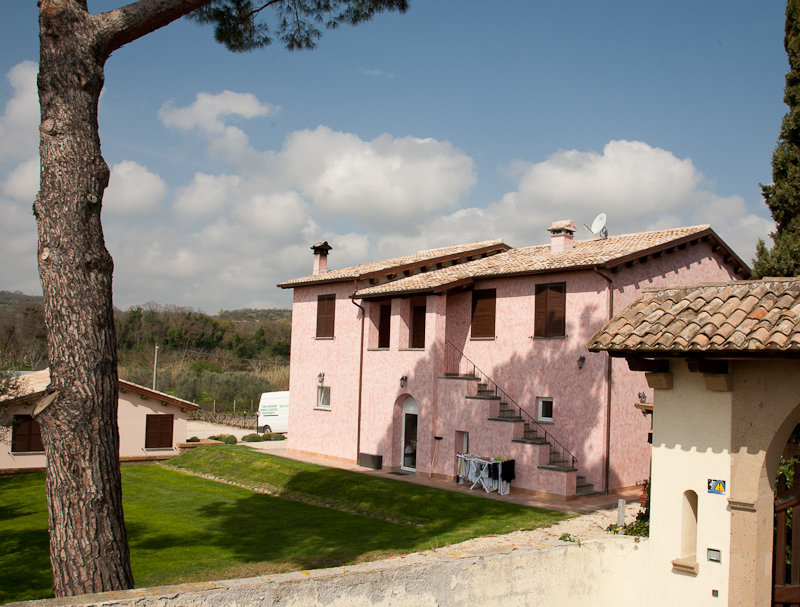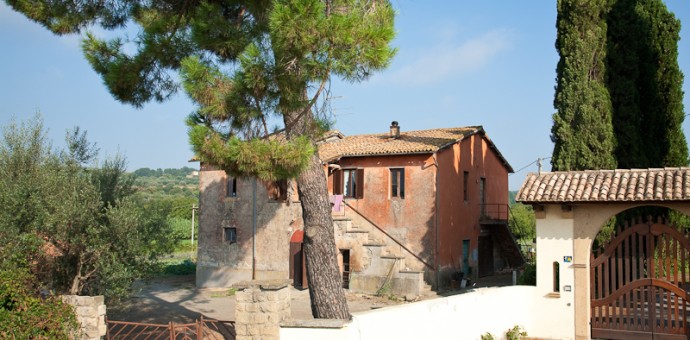Ranting on about pork pink
I am going to permit myself a bit of a rant. Be warned, as I know I’m going to appear to be a snob, so whether you agree or not please leave a comment.
The Italians say that you need a signore to make good wine – in other words a peasant isn’t capable. Well I’d go a bit further. Whereas even certain insects and certainly many animals like birds and even the humble octopus possess a well documented aesthetic sense – the peasant has none: I suppose it’s just not necessary. So it’s particularly heart rending to see the newly enriched Italian peasantry carry on their devastation of a particularly beautiful part of the world. Concrete reigns supreme of course, but it goes beyond that. Here is a case in point.
This old farmhouse on the lovely shores of Lake Bolsena has recently been converted into an Agriturismo. The building was certainly shabby, but it had a charm that comes from being constructed of local materials and allowed to weather for scores of years. The faded paint is a limewash mixed with ground up brick dust – a technique developed by the Romans. Back then building materials were never wasted and demolished buildings were recycled. Bricks and tiles were easily cleansed of their mortar, which didn’t stick like today’s cement, to be gathered into huge piles. The one in Rome is a veritable hill – the Monte dei Cocci in Testaccio near the Protestant cemetery where Keats lies – both are well worth a visit.
The stuccoed buildings of Italian cities and rendered farmhouses were painted with this recycled material which in time weathered, the colours mellowing to leave darker shades under the eaves and windowsills, but also the lime was washed out by the rain leaving the quartz crystals from the brick dust on the surface. In the evening the setting sun reflects in the quartz and the building appears to glow. This glow was often commented on by northerners making the Grand Tour and even gave the name to Bologna ‘La Rossa ‘ (the red) which predated its politics.

Pork Pink Farmhouse
Sadly fewer and fewer of this traditionally painted stucco survives anywhere. If you see a building I suggest you photograph it for posterity and perhaps in a more enlightened age municipalities will insist that refurbished buildings be done using traditional means and local skills. This would not only increase the aesthetic pleasure of strolling around Italian cities and villages but would also provide skilled work for the locals.
The former farmhouse illustrates this perfectly: the joinery is factory produced aluminium and plastic – and white to boot. The pork pink paint is some hideously daubed acrylic on cement stucco which in two or three years will blister and crack and bubble but will never weather in the accepted sense. The facade is festooned with fake plastic carriage lamps while the garden has been all too liberally sown with lamps like upturned goldfish bowls to look at night like a landing pad for extra-terrestrials.
Like a throbbing pustule on the divine landscape this is a building that would not glow in the sunset unless it were on fire.


Il problema della riproduzione degli intonaci tradizionali è purtroppo una realtà in molte città dell’italia..In parte si sono perduti gli artigiani e le tecniche tradizionail, cos’ come le “botteghe” che le tramandavano da capomastro ad allievo..si è pensato di risolvere tutto con intonaci di sintesi, che come hai rilevato, sono incapaci di traspirazione(materiale igroscopico) e in pochi anni si gonfiano e spaccano, cadendo in pezzi.Le città più avvedute dell’emilia romagna e veneto hanno adottato un “piano del colore”, il quale prevede che non soltanto gli edifici importanti vincolati dalla soprintendenza ma anche l’edilizia comune debba sottostare a certe regole.Addirittura nemmeno le parabole satellitari a Venezia possono più essere bianche.Se ne discuteva anni fa, non so ora a che punto sia la cosa..
thanks Nicholas for your always intelligent point of view…
Fabio
grazie Fabio per la tua intelligente risposta, hai assolutamente ragione – se i comuni, o le regioni, intervengono positivamente le città sono più belle e i vecchi mestieri si conservano e vengono tramandati alle generazioni future. Le devastazioni qui nella provincia di Viterbo ma perfino nel Grossetano sono angoscianti.
From the sublime to the hideous – couldn’t agree more. I’m astonished by (some) Italians’ lack of sensitivity to their own aesthetic heritage, one that is envied throughout the world. Although not for much longer, based on this evidence.
Your beautifully-expressed piece, far from being a rant, should be sent to the mayor of every comune in the country.
Ben detto and no, I don’t think you have strayed into those unpleasant waters of snobbery, Patrick. I was chatting with sb here the other day and he was making just the same points as Fabio.
Philosopher’s stone, anyone?